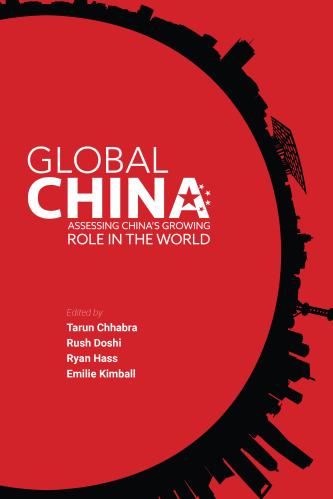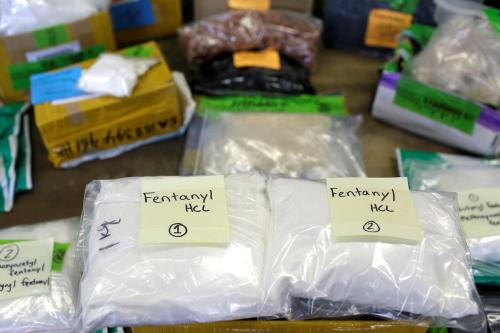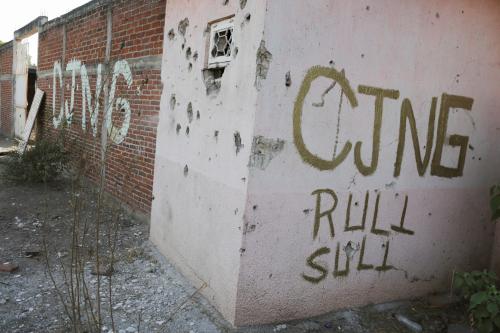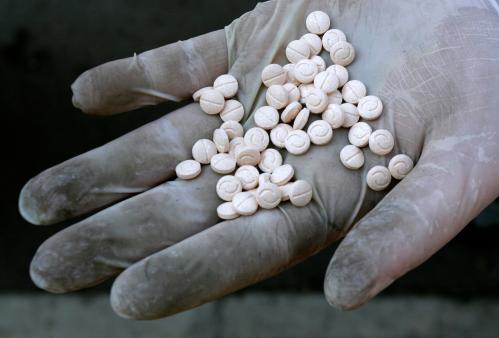This piece is part of a series titled “Nonstate armed actors and illicit economies in 2022” from Brookings’s Initiative on Nonstate Armed Actors.
Opioids are the cause of the deadliest U.S. drug epidemic ever. Between October 2020 and September 2021, another new record number of Americans — 104,288 — died of drug overdose, with opioids accounting for 78,388 deaths. The epidemic became particularly deadly when synthetic opioids, such as fentanyl and its analogs, entered U.S. markets a decade ago and both displaced plant-based opioids and increasingly became mixed by drug traffickers into other drugs, such as methamphetamine and cocaine. Faced with intense U.S. diplomacy, China moved between 2018 and 2019 to regulate fentanyl analogs and two fentanyl precursors. Yet this scheduling has not been sufficient to stem the flow of fentanyl to the United States. It has mostly led to shipments being rerouted through Mexico. As U.S.-China bilateral relations have grown more tense, Beijing’s willingness to cooperate with Washington on counternarcotics has shrunk.
This blog previews a large report of mine to be published by Brookings this month. It is part of a series of Brookings reports on China’s role in various illegal economies, including wildlife, drug, and human trafficking. Building on my prior report, “Fentanyl and geopolitics: Controlling opioid supply from China,” the forthcoming report and this blog are based on some 94 fieldwork interviews I conducted between October and December 2021 in various parts of Mexico and via virtual platforms with international counternarcotics, law enforcement, and government officials, business community representatives, investigative journalists, and scholars based in China, elsewhere in Asia, Australia, New Zealand, Europe, Canada, and the United States.
Fentanyl, methamphetamine, and precursors from China
At first, China was the direct supplier of fentanyl to the United States. More than 5,000 firms make up China’s politically-powerful pharmaceutical industry, the world’s largest in terms of exports of basic chemical ingredients and precursors, and second-largest in terms of annual revenue (more than $100 billion, a third of the value of the U.S. pharmaceutical industry). The industry produces more than 2,000 products in annual output of more than 2 million tons. The world’s leading chemical exporter by value, China also has between 160,000 and 400,000 chemical manufacturers and distributors; many operate without legal approval, others hide behind shell companies, and most are capable of producing fentanyl and hiding it amongst massive output. Until 2019, a myriad of Chinese chemical companies and brokers exported fentanyl to the United States even though such imports were illegal.
Faced with intense U.S. diplomacy, China placed the entire class of fentanyl-type drugs under a controlled regulatory regime in May 2019 and two key fentanyl precursors already in 2018. Following the scheduling, Chinese traders switched to selling precursor chemicals to Mexican drug cartels.
China is also the principal supplier of precursor chemicals for methamphetamine production in East Asia and Mexico. Between the 1990s and mid-2010s, meth was produced in southern China both for domestic consumption and export to Australia and throughout East Asia. At first Beijing was defensive and dismissive about any claims that China was the supply source of Australia’s meth epidemic. But as time passed, it grew willing to cooperate with Canberra. Sino-Australian cooperation culminated in the creation in November 2015 of a joint bilateral counternarcotics task force, Task Force Blaze, which scored important interdiction successes, repeatedly seizing large shipments of meth from China to Australia and leading to arrests of important drug traffickers in both countries. China also shut down domestic production of meth.
But meth precursors and pre-precursors from China continue to head to illicit drug producers in Southeast Asia, such as Myanmar. Chinese drug smuggling networks, such as the Triads, then distribute meth across Asia and to Australia and New Zealand. Mexican drug cartels also source their precursors from China and sell finished meth to the U.S. and elsewhere.

China’s international drug control policies
Fentanyl scheduling and China’s adoption of stricter mail monitoring has created some deterrence effects. Instead of finished fentanyl being shipped directly to the U.S., most smuggling now takes place via Mexico. Like with meth, Mexican criminal groups source fentanyl precursors, and increasingly non-scheduled pre-precursors in China, and then traffic finished fentanyl from Mexico to the U.S.
Some Chinese sellers specifically cater to Mexican drug traffickers. As investigative C4ADS research showed, Chinese sellers bundle uncontrolled fentanyl and meth precursors and common cocaine fillers in their Spanish-language advertisements and highlight their capacities to “clear customs in Mexico.”
China’s enforcement of its fentanyl regulations is highly opaque, but remains limited. Beijing mostly emphasizes that it cannot take actions against companies selling non-scheduled meth and fentanyl precursors even when they blatantly cater to drug cartels. As a result, U.S.-China counternarcotics cooperation remains fraught.
Rejecting U.S. blame of China for the opioid epidemic and emphasizing U.S. responsibility for that calamity, Beijing points to its benevolence in anti-drug cooperation.
But China’s counternarcotics cooperation with the U.S. has been subordinated to the overall deteriorated geostrategic relationship between the two countries. For example, since 2018, prior to which China arrested Chinese fentanyl traffickers based on U.S. tipoffs, China has not acted on U.S. indictments of and U.S.-provided intelligence on Chinese traffickers. China-Australia law enforcement cooperation similarly has withered as Sino-Australian relations have grown more tense.
Indeed, without significant warming of the overall U.S.-China relationship, China is unlikely to intensify its anti-drug cooperation with the United States. U.S. punitive measures, such as sanctions and drug indictments, are unlikely to change that.
The evolution of China’s posture toward illicit methamphetamine production in China and the trafficking of meth precursors from China also provide important insights into the patterns and limitations of China’s international law enforcement cooperation. As with fentanyl precursors, China emphasizes that it cannot act against nonscheduled substances.
Nonetheless, after years of refuting international criticism for its role in meth precursor smuggling amidst burgeoning meth production in Asia, China has intensified its law enforcement cooperation at least with some regional countries. It has also mounted stronger internal regulatory measures even for nonscheduled drugs and has undertaken monitoring and interdiction operations.
China takes counternarcotics diplomacy in Southeast Asia and the Pacific as well as globally, such as the United Nations Office on Drugs and Crime, very seriously. But its operational law enforcement cooperation tends to be highly selective, self-serving, limited, and guided by its geopolitical interests.
Beijing rarely acts against top echelons of Chinese criminal syndicates unless they specifically cross a narrow set of government interests. Arrests of top Chinese Triad leaders have been mostly conducted without China’s cooperation, Asia-based law enforcement officials told me. Unlike their counterparts in Latin America, Chinese criminal groups rarely resort to murder. Moreover, they cultivate political capital with Chinese authorities and Chinese diplomats abroad by also promoting China’s political, strategic, and economic interests.
China-Mexico law enforcement cooperation against the trafficking of fentanyl and precursor agents for meth and synthetic opioids remains minimal. As with the U.S., China rejects co-responsibility and emphasizes that controls and enforcement are matters for Mexican customs and other law enforcement authorities, former Mexican diplomats told me.
China maintains this posture even as the presence of Chinese criminal actors in Mexico, including in money laundering and illicit value transfers (which increasingly feature barter of wildlife products for synthetic drug precursors) are expanding rapidly.
What can and cannot be done
U.S. counternarcotics policy vis-à-vis China can work through multilateral fora and hold at risk China’s self-image as a global counternarcotics policeman. It can also stress China’s self-interest in preventing the emergence of domestic synthetic opioid consumption, even though Beijing points out the lack of synthetic opioid use disorder in China. The U.S. can also encourage China to expand its anti-money laundering efforts, though no extensive near-term progress should be expected. U.S. indictments of Chinese companies and individuals on drug trafficking charges are important law enforcement tools, but will likely only strengthen China’s defensive crouch and limit its counternarcotics collaboration with Washington unless the overall bilateral relationship improves.
There currently is no global political appetite for scheduling a vast number of dual-use chemicals. A next best step could be to encourage the development and adoption of self-regulatory mechanisms for pharmaceutical and chemical industries around the world, including in China. This may reduce the ease of availability of precursor agents for drug trafficking organizations. But the obstacles to such measures being effective are far greater than in the case of anti-money laundering standards in the banking sector.
Indeed, the structural characteristics of synthetic drugs, including the ease of developing similar but unscheduled drugs and their precursors — increasingly a wide array of dual-use chemicals — pose immense structural obstacles to controlling supply, irrespective of political will to prohibit and regulate their use and enforce the regulations. Peter Reuter, Bryce Pardo, and Jirka Taylor argue that even more aggressive Chinese law enforcement actions would not solve the U.S. fentanyl problem. Moreover, other potential suppliers are readily available should China mount better enforcement measures, including in India, where Mexican cartels have already developed networks, Nigeria, and South Africa, already significant importers of precursors and producers of other synthetic drugs.
However, even with the limitations to regulatory and law enforcement policies, international cooperation against drug trafficking networks can save some lives, which more than justifies efforts to push China to delink counternarcotics from geopolitical bargaining.










Commentary
China and synthetic drugs: Geopolitics trumps counternarcotics cooperation
March 7, 2022